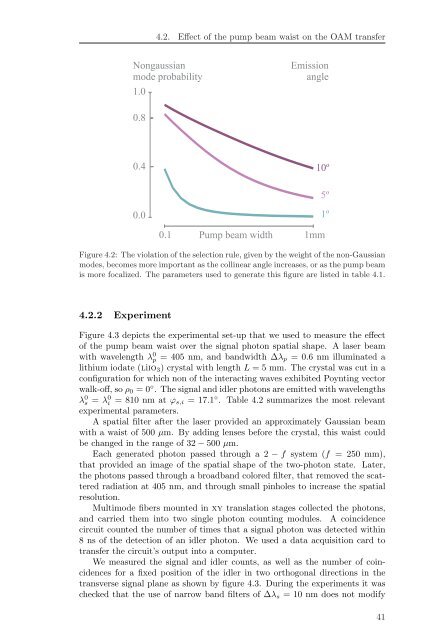Spatial Characterization Of Two-Photon States - GAP-Optique
Spatial Characterization Of Two-Photon States - GAP-Optique
Spatial Characterization Of Two-Photon States - GAP-Optique
Create successful ePaper yourself
Turn your PDF publications into a flip-book with our unique Google optimized e-Paper software.
1.0<br />
0.0<br />
4.2. Effect of the pump beam waist on the OAM transfer<br />
Nongaussian<br />
mode probability<br />
0.8<br />
0.4<br />
Emission<br />
angle<br />
10º<br />
0.1 Pump beam width 1mm<br />
Figure 4.2: The violation of the selection rule, given by the weight of the non-Gaussian<br />
modes, becomes more important as the collinear angle increases, or as the pump beam<br />
is more focalized. The parameters used to generate this figure are listed in table 4.1.<br />
4.2.2 Experiment<br />
Figure 4.3 depicts the experimental set-up that we used to measure the effect<br />
of the pump beam waist over the signal photon spatial shape. A laser beam<br />
with wavelength λ 0 p = 405 nm, and bandwidth ∆λp = 0.6 nm illuminated a<br />
lithium iodate (liio3) crystal with length L = 5 mm. The crystal was cut in a<br />
configuration for which non of the interacting waves exhibited Poynting vector<br />
walk-off, so ρ0 = 0 ◦ . The signal and idler photons are emitted with wavelengths<br />
λ 0 s = λ 0 i = 810 nm at ϕs,i = 17.1 ◦ . Table 4.2 summarizes the most relevant<br />
experimental parameters.<br />
A spatial filter after the laser provided an approximately Gaussian beam<br />
with a waist of 500 µm. By adding lenses before the crystal, this waist could<br />
be changed in the range of 32 − 500 µm.<br />
Each generated photon passed through a 2 − f system (f = 250 mm),<br />
that provided an image of the spatial shape of the two-photon state. Later,<br />
the photons passed through a broadband colored filter, that removed the scattered<br />
radiation at 405 nm, and through small pinholes to increase the spatial<br />
resolution.<br />
Multimode fibers mounted in xy translation stages collected the photons,<br />
and carried them into two single photon counting modules. A coincidence<br />
circuit counted the number of times that a signal photon was detected within<br />
8 ns of the detection of an idler photon. We used a data acquisition card to<br />
transfer the circuit’s output into a computer.<br />
We measured the signal and idler counts, as well as the number of coincidences<br />
for a fixed position of the idler in two orthogonal directions in the<br />
transverse signal plane as shown by figure 4.3. During the experiments it was<br />
checked that the use of narrow band filters of ∆λs = 10 nm does not modify<br />
5º<br />
1º<br />
41



